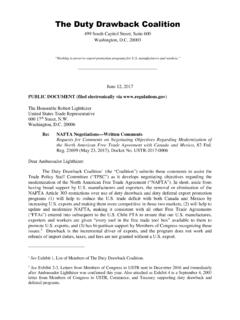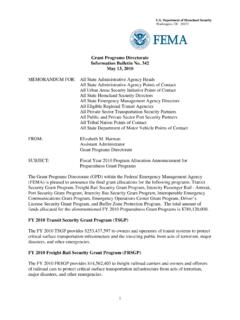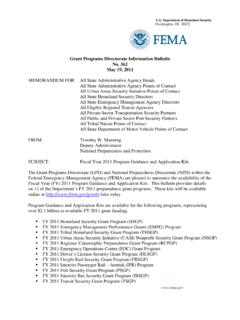Transcription of Container Tracking System – Dwell Time and Transit Time ...
1 Container Tracking System Dwell time and Transit time Management at the Port of Halifax Applicant: Halifax Port Authority Jim Nicoll Manager, Information and Technology Services Box 336 Halifax, Nova Scotia Canada B3J 2P6 Date Submitted: June 15, 2007 Partner: Nicom IT Solutions David Nicholson Partner Suite 8, 6960 Mumford Rd. Halifax, Nova Scotia Canada B3L 4P1 Container Tracking System Dwell time and Transit time Management at the Port of Halifax Table of Contents 1. Port Description Page 1 2. Introduction 1 3.
2 Goals and Objectives/Business Problem 2 4. Discussion Background Objectives and Methodology Hardware and Software Project Costs Performance Measures Award Criteria 3 3 4 12 12 13 13 5. Conclusion 15 1 1. Port Description The Port of Halifax is a full service port, and offers a variety of facilities for bulk, breakbulk, roro and Container cargo, as well as modern cruise facilities. Halifax is Canada s third largest Container port, with Container operations located in its South End and Fairview Cove Container terminals. The Port of Halifax is the only seaport on the east coast deep enough to accommodate fully laden, post-Panamax vessels.
3 Closer to Europe than any other east coast port of call, the first destination for carriers sailing from Asia through the Suez Canal, and with seamless intermodal connections to and from the heartland of North America, the Port of Halifax is Canada's Atlantic Gateway to the world. The Halifax Port Authority (HPA) is an agent of the Government of Canada created in 1999 pursuant to the Canada Marine Act. The mandate of the HPA includes: the administration of Halifax Harbour; the regulation of port operations; the management and development of port facilities; the provision of port services; and, the promotion of trade through the Port of Halifax. 2. Introduction As a key gateway port, the Port of Halifax moves a significant volume of cargo inland by rail.
4 Concerned with the quality and consistency of the service provided to its customers, the Halifax Port Authority (HPA) initiated a Service Standard Report to monitor two key performance indicators: Container Dwell times; and Transit times. With thousands of containers moving each year, the task of capturing movement event data required for Dwell time and Transit time monitoring was nearly impossible to perform manually. The HPA, working in cooperation with its stakeholders, has now developed a Container Tracking System (CTS) to automate the data collection process, measure and monitor Dwell times and Transit times, and make the Container movement event data available to its stakeholders for the purpose of Tracking import containers from the port to their ultimate destination.
5 Since implementing this System , Container Dwell times have been reduced by over 37%, and are much more consistent. Customers of the Port of Halifax are now able to track detailed event information for each import Container at each stage of its inland journey, further improving their logistics planning capabilities. 2 3. Goals and Objectives / Business Problem The Halifax Port Authority (HPA) owns two Container terminals within the Port of Halifax. Over 550,000 TEU pass over these terminals each year, with the vast majority of these containers moving by rail to and from inland locations. While the HPA does not operate the terminals, it does have a role to play in bringing this business to the Port of Halifax, and in making sure that customers of the Port remain satisfied with the service they receive in Halifax.
6 Quality of service and consistency of service are of primary concern. The HPA has worked with its many stakeholders to identify the key metrics related to the quality and consistency of service at the Port of Halifax. Two key measures are: Dwell time the amount of time that an import Container sits at a marine terminal (terminal Dwell time ) or rail terminal (rail Dwell time ) before commencing its inland journey; and, Transit time the total elapsed time from Container discharge to arrival at its ultimate inland destination. Shorter Dwell times indicate that terminal and rail resources are being used effectively, and results in inbound cargo being delivered to its final destination more quickly.
7 Accurate Transit time metrics allow for improved logistics planning on the part of customers receiving goods through the Port of Halifax. The HPA, through its Smart Port cooperative initiative, worked with its stakeholders to collect and report the key metrics related to Dwell time and Transit time on a daily basis. A Service Standard Report was developed and distributed to interested stakeholders each day. However, the data collection process relied on input from a large number of stakeholders, and much of the collection and reporting process was manual and very labour intensive. As a result, the Service Standard Report was often not produced in a timely manner. The primary objective of the Container Tracking System (CTS) was to reduce the level of effort required to produce the Service Standard Report by automating the data collection and report preparation and distribution processes.
8 This allows the accurate and timely determination of current Dwell times and Transit times to ensure that service commitments are being met. A secondary objective was to collect sufficient empirical data to allow the analysis of Dwell time and Transit time patterns and trends. This serves as a key tool to identify and investigate the causes of unacceptable Dwell times and Transit times so that preventive and corrective action can be taken and these times can be reduced. 3 A final objective was to allow cargo owners the ability to track detailed event information for each import Container at each stage of its inland journey. This provides visibility to cargo movements through the Port of Halifax, further improving the logistics planning capabilities of customers of the Port.
9 4. Discussion Background Every import Container will have a number of events associated with it as it moves along its inbound journey, from vessel discharge to discharge from a rail car at destination. The events are summarized in Table 1. Table 1 Container Movement Event Definitions Container Movement Event Name Description Container Discharge Container discharges from the import vessel. Container Ramp Container is loaded onto a rail car at the marine terminal. Terminal Departure from Halifax Rockingham Rail Terminal Rail car carrying the Container is made up into a train and leaves Halifax to begin its inland journey. Terminal Arrival Rail car carrying the Container arrives at an inland rail terminal.
10 Terminal Departure Rail car carrying the Container departs from one inland rail terminal, destined to another inland rail terminal. Note that there may be several pairs of Terminal Arrival and Terminal Departure events as the rail car moves through multiple rail terminals on its journey to final destination. Container Deramp Container is finally unloaded from the rail car at destination. 4 The relationship between the Container movement events and Dwell times and Transit times are illustrated in Figure 1. Figure 1 Events, Dwell Times and Transit Times The Container Tracking System is designed to capture each movement event for each Container , and to make this event data available for Container status inquiries and Dwell time and Transit time calculation, analysis and reporting.
















